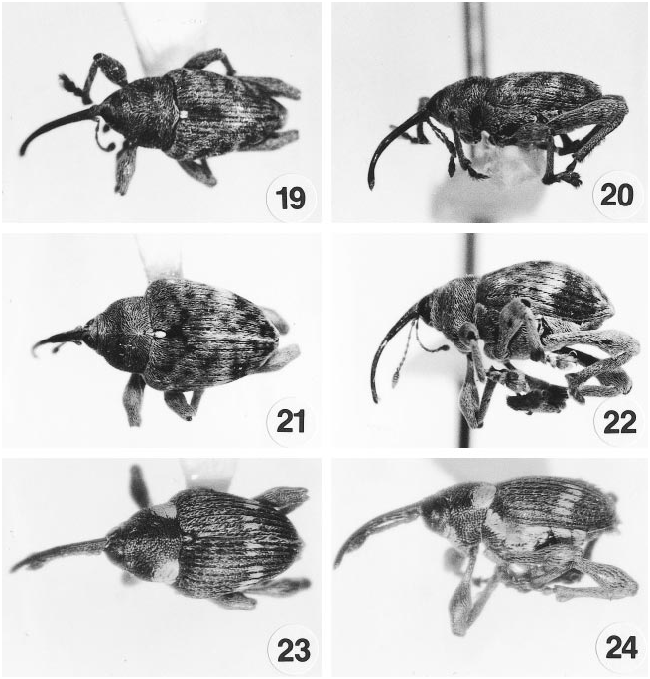Curculio matthewi Pelsue and Zhang
|
publication ID |
https://doi.org/10.1649/0010-065x(2000)054[0467:arotcf]2.0.co;2 |
|
DOI |
https://doi.org/10.5281/zenodo.15700374 |
|
persistent identifier |
https://treatment.plazi.org/id/8C170A27-B606-947B-FEA4-A5D4FED1FD10 |
|
treatment provided by |
Carolina |
|
scientific name |
Curculio matthewi Pelsue and Zhang |
| status |
sp. nov. |
Curculio matthewi Pelsue and Zhang View in CoL , New Species
Figs. 23–24 View Figs , 66–69 View Figs
HOLOTYPE. China. Xishuangbanna : Male [China/ Yunnan /Xishuangbanna/650 M/ 19 May 1958 / S. Wang] ( IZAS)
PARATYPE (S). (3) China. (2) males ( 1) female [China/ Yunnan / Xishuangbanna /650 M/ 19 May 1958 / S. Wang] ( FWPC)
Recognition Characters. Smallsized, broadly ovate; derm fuscous; hind femoral tooth largesized; pronotum with two large basolateral macula; elytra with fascia of clavate cretaceous scales at midpoint on all intervals except 3 and 9.
Description. Male: Length: 2.6–3.0 mm (mean = 2.8). Width: 1.5–1.7 mm (mean = 1.6). Head: Smallsized, slightly convex; punctures small, with small narrow, elongate, cinerous scales; eyes large, oval, with moderately coarse facets. Frons, narrow, 0.15 as broad as head across eyes; clothed with narrow, elongate, cinerous scales. Rostrum: Length: 1.6 mm, 0.57 as long as body; derm testaceous; cylindrical, margins subparallel, broad at base, gradually tapering to apex; slightly arced; middorsal carina from frons ending before antennal insertion, two lateral carinae from frons to antennal insertion, deep oval punctures between carinae; scrobe ventral; scape inserted at midpoint. Antennae: Length: Scape 0.6 mm; Funiculus: segment one 0.2 mm, two 0.15 mm, three 0.1 mm; four 0.1 mm, five 0.1 mm, six 0.1 mm, seven 0.1 mm, club 0.35 mm; funicle 1.1 mm; scape 0.55 as long as funicle; clothed with narrow, elongate, cinerous scales and apical erect setae; club elongate, oval, compact, with velvety pile, few erect setae, as long as funicular segments 1–7. Thorax: Length: 0.8 mm. Width: 1.2–1.3 mm (mean = 1.25 mm). 0.64 as long as broad; disc margins subparallel, broadly rounded to constriction, slightly convex in lateral view, punctures small, close together, shallow, clothed with elongate, clavate, testaceous scales; two dorsobasal macula of elongate, clavate, cretaceous scales on each side of disc; pleuron clothed with elongate, clavate, testaceous scales; mesosternal intercoxal process prominent, clothed with broad, clavate, cretaceous scales; scutellum small, longer than broad, bifid, clothed with cretaceous scales; mesepimeron densely clothed with broad, clavate, cretaceous scales; mesepisternum clothed with few clavate, testaceous scales; metepisternum clothed with short, narrow, testaceous scales anteriorly, with a broad, clavate, cretaceous macula posteriorly; metasternum clothed with broad, clavate, cretaceous scales; procoxae clothed with narrow, elongate, cretaceous scales. Elytra: Length: 1.9 mm. Striae moderately deep, punctures without scales; shallow scutellar declivity; intervals broad, flat, clothed with elongate, clavate, testaceous scales mixed with few white scales; midpoint with macular fascia on interval 2, 4, 5–8 of clavate, cretaceous scales; disc feebly convex; crosshatched setae short, thick, and testaceous. Legs: Hind femur 2.7 mm in length, largesized tooth, wedge shaped with acute apex; profemur with medium tooth; mesofemur with large tooth; derm fuscous basally, fuscorufous apically, clothed with narrow, elongate, white scales; tibiae sinuate; pro and mesouncus large; metauncus small. Abdomen: Sternite 1 as long as 2 behind coxal cavity, with median shallow declivity; sternite 2 ascending to 3; sternite 3 longer than 4; sternites 3 and 4 combined longer than 5; sternites 1 and 2 densely clothed with clavate, cretaceous scales laterally, smaller, narrower, white scales medially; sternites 3–5 clothed with narrow, elongate, cinerous scales; sternite 5 with truncate apex, with lateral apical tufts of white setalike scales. Pygidium: Small ; clothed with tuft of dirty white, setalike scales. Genitalia: Median lobe of aedeagus 0.5 mm in length, 0.2 mm in width, margins rather broad then narrowing to arced apices, thin in lateral view, apex broadly narrowed to a rounded point; apodeme 0.7 mm in length ( Figs. 66–68 View Figs ).
Female: Length: 3.0 mm. Width: 1.8 mm. Rostrum: Length: 1.8 mm. Scape inserted in basal half. Thorax: Length: 1.9 mm. Width: 1.9 mm. Disc with middorsal carina; two lateral vitta of elongate, clavate, white scales, extending from basal macula to anterior margin of pronotum. Elytra: Length 2.1 mm. Abdomen: Sternite 1 with broad, clavate, cretaceous scales laterally and medially; sternite 3 with small median macula of broad, clavate, cretaceous scales; sternite 5 with median declivity, with narrow, elongate, erect, white, setalike scales. Pygidium: Concealed. Genitalia: Spermatheca ramus and collum undifferentiated; cornu thick basally evenly tapered to acute apex ( Fig. 69 View Figs ).
Distribution. China: Yunnan Province, Xishuangbanna, 650 M, 19 May 1958, S. Wong.
Remarks. This is a a small species that cannot be confused with any other species in this group. However, it looks similar to C. delicatulus Marshall (compared with Holotype in collection of BMNH by senior author), but lacks the subscutellar short cretaceous vitta on interval 1 and has larger basolateral cretaceous macula on pronotum. It is named in honor of senior author’s grandson Matthew.
| IZAS |
Institut Zoologii Akademii Nauk Ukraini - Institute of Zoology of the Academy of Sciences of Ukraine |
No known copyright restrictions apply. See Agosti, D., Egloff, W., 2009. Taxonomic information exchange and copyright: the Plazi approach. BMC Research Notes 2009, 2:53 for further explanation.
|
Kingdom |
|
|
Phylum |
|
|
Class |
|
|
Order |
|
|
Family |
|
|
Genus |


